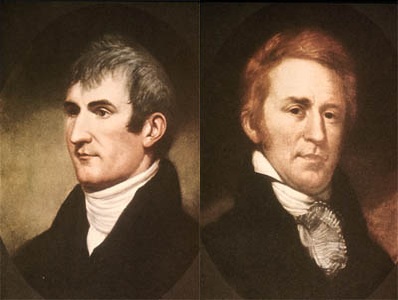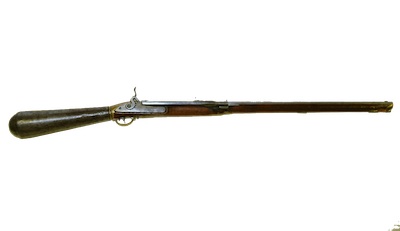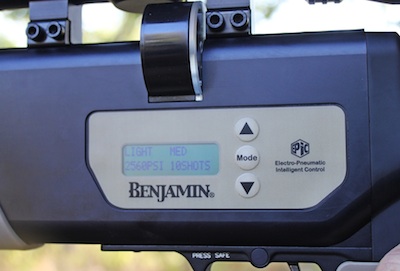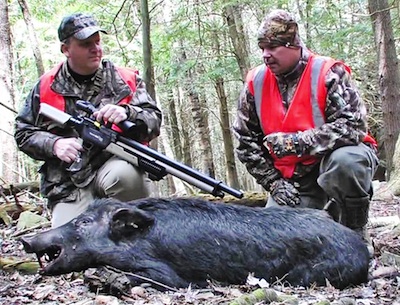Not long ago I spent a little time bumping around hunting forums when I crashed an air-rifle-hate-club. Post after post proudly announced how unethical, childish, foolish and laughable it was to even consider using air rifles for hunting larger animals, including my favorite, feral hogs. While I truly believe we shouldn’t drive wedges among our ranks I also believe it’s more productive to share the love… err, knowledge, on topics we actually know something about; to that end I suppose I’m a black and white sort of guy.

Open Note to Air Rifle Haters the World Over
I’ve sat idly and quietly by and researched air rifles fairly extensively, including their historical context, while many unstudied legalists brag and boast of their knowledge on the ethics of air rifles. They are always ready to pounce on unsuspecting air rifle hunters while suggesting that larger calibers are the latest in air rifle innovation. Well, I’ve got news for the haters out there, as well as for those whose love for air rifles take them back to the days of their backyard Red Riders – large caliber air rifles were big enough for big game… even big enough to chart the west!
Consider the following excerpt:
August 30, 1803 – “Left Pittsburgh this day at 11 ock with a party of 11 hands 7 of which are soldiers, a pilot and three young men on trial they having proposed to go with me throughout the voyage. Arrived at Bruno’s Island 3 miles below halted a few minutes. Went on shore and being invited on by some of the gentlemen present to try my airgun which I had purchased brought it on shore charged it and fired myself seven times fifty-five yards with pretty good success.” (Lewis and Clark Journals, Volume 1)
 While air rifles date back some 400 years, the most famous historical use Americans relate air rifles to is the Lewis and Clark Expedition from 1803 to 1806. Lewis and Clark began their expedition to chart the west completely outgunned, outmanned and under-supplied. By the time the expedition reached full speed only 38 hands were on deck. Worse, only one keel boat of supplies, including 22 muzzleloaders and one air rifle accompanied the ill-supported exhibition.
While air rifles date back some 400 years, the most famous historical use Americans relate air rifles to is the Lewis and Clark Expedition from 1803 to 1806. Lewis and Clark began their expedition to chart the west completely outgunned, outmanned and under-supplied. By the time the expedition reached full speed only 38 hands were on deck. Worse, only one keel boat of supplies, including 22 muzzleloaders and one air rifle accompanied the ill-supported exhibition.
The single pre-charged pneumatic (PCP) airgun, now known as the Girandoni .46-caliber, 22-shot Repeating Air Rifle was quite possibly the expedition’s best defense; in fact, as a result of its use, many regard the Girandoni rifle as the real “gun that won the west”.
Interestingly enough, the Lewis and Clark journals, comprised of over 1 million words spanning 13 volumes, as assembled by University of Nebraska Press and Dr. Gary Melton, reference the Lewis’ air rifle no less than 39 times, often as a deterrent to violence at the hands of Native American tribes.
 Detailed entries describe a recurring strategy when encountering tribes that vastly outnumbered the 38 explorers. The team dressed in full uniform, paraded into tribal settlements and bestowed gifts on tribal chiefs. After their grand entrance, Lewis demonstrated his repeating air rifle. The firearm could shoot up to 40 rounds per 800-psi charge and included a 22-round tube magazine capable of being emptied in less than 30 seconds. At one point, an overzealous chief tried to strong arm Lewis and Clark into revealing the contents of the expedition’s keel supply boat; however, the idea that confrontation could result in 38 men firing 22 rounds in less than 30 seconds caused the chief to back down.
Detailed entries describe a recurring strategy when encountering tribes that vastly outnumbered the 38 explorers. The team dressed in full uniform, paraded into tribal settlements and bestowed gifts on tribal chiefs. After their grand entrance, Lewis demonstrated his repeating air rifle. The firearm could shoot up to 40 rounds per 800-psi charge and included a 22-round tube magazine capable of being emptied in less than 30 seconds. At one point, an overzealous chief tried to strong arm Lewis and Clark into revealing the contents of the expedition’s keel supply boat; however, the idea that confrontation could result in 38 men firing 22 rounds in less than 30 seconds caused the chief to back down.
While 22 muzzleloaders also accompanied the explorers, the Girandoni’s accuracy (largely as a result of a rifled barrel), repeatable firing and ability to shoot without depleting precious defense resources such as black powder also made the Girandoni a perfect choice for hunting big game animals.
It’s quite conceivable that without the Girandoni’s influence, the expedition could have been massacred early in the expedition. As a result, many historians agree the Girandoni air rifle is the most important, yet, perhaps, the most overlooked firearm in American history. Without it, western expansion may not have occurred – a haunting point of contention and much more than a notch in the belt of airgun success.
Leaping Forward, Thinking Back
A short 175 years later found my father hovering over me, coaching and coaxing while I took my first shots with a Daisy Red Ryder BB-Gun. The truth is that I cut my marksmanship teeth on air rifles long before my first experience with the .22-caliber Marlin my father handed me at 10 years of age.
Another 10 years, and tens of thousands of rounds from BBs to .45-70’s had been sent downrange by the subtle squeeze of my trigger finger. Qualifying on range day in Marine Corps Boot Camp was a breeze; in fact, I never shot less than Rifle Expert and Pistol Sharpshooter during my eight years of service and I owe it all to air rifles. I even killed my first rabbits and squirrels with that Daisy, but nowadays I need a bit more. I’ve grown up as have most of the animals I pursue. Some might say I’ve gotten tougher over the years and I know, without a doubt, that my favorite prey, feral hogs, are even tougher than me.
Right Here, Right Now
Leaping another 35 years into the future to 2013, one might still find me still settled in behind the matte barrel and sturdy stock of a trusty air rifle, or even better, hovering over the top of my own son, coaxing, coaching and encouraging. Jacob is “cutting his teeth” like I did with air rifles; fortunately, for his sake, slide rules are tough to come by nowadays; like today’s ultra-cool, high-tech calculators, Jake gets to shoot some pretty awesome firearms whether we are just plinking or on my next favorite hunt.
The Benjamin Rogue = Boar Bustin’ Fun!
The Lewis and Clark .46-caliber Girandoni fired up to 40 shots on a single charge; however, charging the rifle was a task that tested even the toughest of men. Using a system similar to today’s bicycle pumps, it took as many as 1,500 repetitions to fully charge an air tank encapsulated in the stock. Orders to charge Lewis’ Girandoni likely resulted in a number of sour faces throughout the 3-year expedition.
Fortunately, today’s charging systems are not nearly as arduous. Sure, smaller caliber air rifles may operate off of factory sealed disposable tanks or age old hand-pump; however, high-powered, boar bustin’ air rifles like Crosman’s Benjamin Rogue .357 are easily charged up to 3,000-psi.
While both the Girandoni and the Rogue are considered PCP systems, the Rogue’s patent-pending ePCP™ technology means more versatility and increased power while the patent-pending eVALVE system makes for more efficient use of the air charge via precision, user-selected distribution options. Hog hunters not only have some great ammunition choices to make, including round-nosed, flat-nosed and Nosler’s eXTREME ballistic tip bullets, they can even use their own cast .357-caliber pellets. For hogs I recommend the 145-grain Nosler Ballistic Tips.
 The Rogue’s EPiC™ LED display and selection buttons allow configuration of key ballistic elements including medium-high foot-pounds of energy/velocity options and bullet weights of medium (up to 145 grains) and high (over 145 grains). The rifle even includes manual mode setting. In manual mode, the serious hog hunters can calibrate air pressure and valve-release delay to experiment with ballistics and discover their own best hog-stoppin’ ammo.
The Rogue’s EPiC™ LED display and selection buttons allow configuration of key ballistic elements including medium-high foot-pounds of energy/velocity options and bullet weights of medium (up to 145 grains) and high (over 145 grains). The rifle even includes manual mode setting. In manual mode, the serious hog hunters can calibrate air pressure and valve-release delay to experiment with ballistics and discover their own best hog-stoppin’ ammo.
Currently, I use two six-round magazines to ensure I have everything I need to hammer hogs as quickly as I can cycle the bolt! I topped my Rogue with Crosman’s Center-Point 4-16x44mm riflescope, and accessorized the standard picatinny rail, located on the bottom side of the handguard with a Hawglite Sabre from www.Hawglite.com and a Harris sitting bipod from Brownells. Between the bipod and adjustable stock, comfort comes regardless of the landscape. Incidentally, shots on hogs should happen within 75 yards; 50 yards is even better!
Calling All Skeptics
Kinetic Energy (KE) = Dead Hogs
While it’s true that those .17- or .22-caliber pellets might not be enough to bring down bruisers, .357s from my Benjamin Rogue are more than enough to fill Hog Heaven. However, shooting should remain within 75 yards and still requires effective shot placement and penetration. KE is the essential punch required for penetration to a hog’s vitals
*Remember the formula to find out your KE? (Weight x Velocity squared)/450,240
Consider a 145-grain Nosler .357-caliber pellet traveling at 775 fps, an average shot statistic for the Benjamin Rogue Air Rifle. We multiply 145 x 775 squared then divide by 450,240. That is 145 x 600,625/450,240. Now we multiply again and prepare to divide. 87,090,625 divided by 450,240 equals 193.43 foot-pounds of energy, comparable to that of your average .45 ACP handgun, arguably the most hog hunting sidearm in the woods; in fact, many hog hunt with a .45 ACP, as their primary firearm!
400 Years of Legacy Building and Growing
 Over the past 400 years worldwide, air rifles have enjoyed a rich history in warfare and hunting. Since the 19th century, here in these United States, they’ve also garnered a history steeped in nostalgia as well as legacy building. Even now watching kids line up to shoot air guns or being there on their first air gun hunt still pulls on heartstrings of old salts like me. As I watch my own son plink soda cans off a tree stump I can’t help but get excited about future adventures in the hog woods. That Benjamin Rogue is sure to the perfect answer for his first hog!
Over the past 400 years worldwide, air rifles have enjoyed a rich history in warfare and hunting. Since the 19th century, here in these United States, they’ve also garnered a history steeped in nostalgia as well as legacy building. Even now watching kids line up to shoot air guns or being there on their first air gun hunt still pulls on heartstrings of old salts like me. As I watch my own son plink soda cans off a tree stump I can’t help but get excited about future adventures in the hog woods. That Benjamin Rogue is sure to the perfect answer for his first hog!
*Nearly all states allow hunting with air rifles in some form or another; check your state regulations.
Hunt hard, hunt often and consider taking an air rifle on your next hog hunt!
Learn more about Lewis and Clark’s incredible expedition at www.archives.gov/education/lessons/lewis-clark
Learn more about the Girandoni Air Rifle visit home.NRA.org/history and type Girandoni Air Rifle in the search field.
Visit www.Crosman.com, www.Brownells.com or www.Hawglite.com to learn more about the Benjamin Rogue .357 and other great shooting and hunting accessories.
*Photos courtesy of Kevin Reese, Ed Schultz (Crosman Prostaff), Crosman, U.S Army

